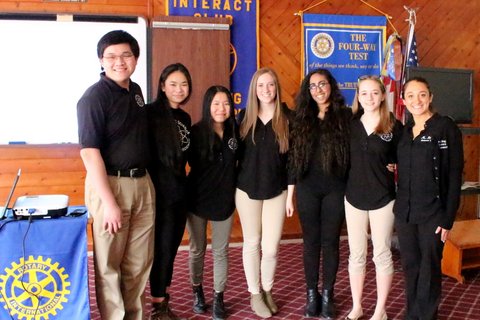Pawling High School Science Research Students Present to Pawling Rotary
By Susan Stone
At noon on Tuesday, March 1, Pawling High School students enrolled in Ms. Gillian Rinaldo’s Science Research program spoke at Pawling Rotary’s regular Tuesday lunch meeting in the Lathrop Building. Those Rotarians in attendance were awestruck at the depth of commitment and breadth of knowledge that these young scientists bring to this relatively new program that is now offered to students in our district.
According to the information provided by Ms. Rinaldo, “Science Research is a three-year course accredited by the New York Department of Regents Education and SUNY Albany. The philosophy behind this course is to provide an authentic, process-based education using the principles of inquiry in science education.
Science Research utilizes immersion in a scientific topic of the student’s choice to integrate knowledge across curriculum and provide the opportunity for extended investigation and research at a graduate level. Students gradually expand their investigation, during a three-year time span: from background research, through experimental design and data collection, to publication for scientific competitions.
The Science Research course skills include portfolio assessment, time management, public presentations, communication with professionals, and student goal setting.”
Ms. Rinaldo is a fourth year science teacher at Pawling High School and this is currently the second of a three year ‘spiraling course’ in which Science Research has been offered to a select group of students. “It is a rigorous course, which begins in their sophomore year of high school and continues until they graduate …. At the end of this process, students have completed PhD level research and participated in a variety of scientific symposia,” states Ms. Rinaldo . In addition, “students work with an expert in their field of research at a variety of colleges, who mentor [them]… during the process of experimental design, data collection and competition preparation.”
The students involved in Science Research are impressive in their ability to present their interests and are passionate about their subject of inquiry. The results of their research will impact the scientific community by adding to the existing body of knowledge, bringing the current investigation closer to real world application in the fields of medicine and conservation.
Information about the remarkably talented students currently enrolled in Science Research, along with their areas of study, was submitted by Ms. Rinaldo and appears below:
Andra Sullivan is a junior at Pawling High School and is currently in her second year of the Science Research Program. This past summer, Andra worked at the Cary Institute of Ecosystem Studies in Millbrook, New York. During this time, she worked in researching Lyme Disease within ticks. She will be interning this summer at the Neural Stem Cell Institute in Rensselaer, New York, under the guidance of Chris Fasano. Her research is regarding the measuring of neurotoxicity of certain substances in neural stem cells. This research can result in a better understanding of the environmental causes of Autism Spectrum Disorders and other neurological disorders.
Aishwarya Govindarajan is a junior at Pawling High School, and is in her second year of the Pawling Science Research Program. Aishwarya spent this past summer studying cell competition in Drosophila at Columbia University Medical Center. The measurement of the ability of cells to eliminate weaker cells and allow beneficial cells to thrive, and the suppression of tumors, can allow for an understanding of cell production and manipulation. Such an understanding can be applied to stem cell research as well as cancer research. She plans to continue research on cell competition this summer with Dr. Laura Johnston at Columbia University Medical Summer.
Alicia Chu is a junior at Pawling High School and is currently in her second year of the Science Research Program. This past summer, Alicia helped conduct research on recurrent laryngeal nerve injury in Professor Sansar Sharma’s laboratory at New York Medical College with her mentor, Dr. Ignacio Hernandez-Morato. There, she was able to learn and observe various laboratory techniques associated with professional scientific research. In this experiment, she was involved with researchers who were examining how the amount of Netrin-1 affected reinnervation of the recurrent laryngeal nerve.
Abigail Reid is a sophomore at Pawling High School and is currently in her first year of the Science Research Program. She is interested in animal cognition and problem-solving abilities, with applications in conservation. At the beginning of December, she obtained a mentorship with Alan Tousignant, the director of the Trevor Zoo, and is in the process of designing her experiment. Her research is hoping to assess the problem-solving skills of wild and captive red wolves, possibly demonstrating how intelligent this species is and what means need to be taken to reduce their negative interactions with humans. Abby plans on working with the critically endangered red wolves at several zoos and breeding facilities, including the Wolf Conservation Center and Beardsley Zoo. Also, she is attempting to obtain a research permit to conduct field studies in North Carolina with the wild wolves.
Kim Bonanno is a junior at Pawling High School and is currently in her second year of the Science Research Program. This past summer, Kim was able to conduct her own research at Randall’s Island Park located in New York City between the Bronx, Manhattan, and Queens. Her research was carried out with her mentor Christopher Girgenti, the Manager of the Randall’s Island Park Wetlands Team. With her mentor, Kim had studied the effects of light intensity on the growth and mortality of Crassostrea virginica (the Eastern Oyster). The research conducted by Kim and her mentor will be very beneficial to the conservation and preservation of the Eastern Oyster in urban areas similar to New York City. This year, Kim hopes to begin her next project having to do with the adaptive ability of the Eastern Oyster when exposed to three known stressors. She hopes to receive help from a PHD in the area of environmental and marine [biology] who can brainstorm and assist her on her new project.
Matthew Badia is a junior at Pawling High School and is in his second year of the Science Research Program. Last year, he found his mentor, Dr. Zofia Gagnon at Marist College in Poughkeepsie, New York. She has agreed to work with him studying the effects of varying concentrations of S-Amphetamine, fluoxetine, and triclosan on Orconectes immunis, a common crayfish to the Northeast, in the Hudson River testing fluctuations in magnesium and calcium concentrations. S-amphetamine is a stimulant used to treat attention deficit disorders and is known to alter magnesium concentration in the brain and calcium concentrations in the skeleton. Fluoxetine is one of the most common antidepressants on the market and triclosan is the most common antibacterial and antifungal available. In addition, these chemicals were also tested on Peltandra virginica, a common plant, as a different model. As human wastewater is being fed into rivers, contaminated waterways are becoming a major issue nationwide. Pharmaceuticals like amphetamine and fluoxetine, and Personal Care Products like triclosan are entering the environment and causing significant damage on marine organisms. This research hopes to further investigate the effects of these three chemicals on the natural aquatic environment.
Ms. Rinaldo maintains that she “has found the method of facilitating rather than dictating to be a highly beneficial style of teaching in this college level course… [she has also] learned that if students construct their own learning experiences they will not only retain information longer, but they will also become more confident in their abilities and [this method] will foster an exciting and engaging learning environment by utilizing real life connections in scientific research.”
Ms. Rinaldo is also actively involved in the Pawling community and the school, coaching the girls Varsity Soccer team and the Varsity Dance team at Pawling High School. Gillian has also been involved in the re-beautification of the high school courtyard, by incorporating it into environmental science as a sustainability project. She has developed curricula for courses such as Marine Biology, Math, Science and Technology and AP Biology.
Rotarians and guests in attendance at last Tuesday’s meeting were dazzled and delighted at the level of creativity, enthusiasm, and professionalism that these students, under the mentorship of Gillian Rinaldo, have demonstrated, and look forward to hearing about the results of their research.


